California's housing shortage and the unintended consequences of legislative policy choices made over the past decade are driving people out of the state and hurting the economy, writes Dan Walters. (AP File)

- California’s 5.2% unemployment rate is tied for second highest in the U.S.
- “There is little doubt that California is not doing as well as it has in the past," analyzes Beacon Economics.
- A severe housing shortage is driving prices up and people out of the state.
Share
|
Getting your Trinity Audio player ready...
|
California’s unemployment rate, 5.2% of its labor force in July, is no longer the nation’s highest after months of having that dubious distinction.
While California’s July rate was unchanged from June, Nevada’s creeped ahead — or behind — with a 5.4% rate, so California is now tied with Illinois for second place among the states.
The jobless rate translates into slightly over 1 million of California’s 19.4 million-person labor force being unemployed. The labor force is defined as adults of working age who either hold jobs or are seeking work.
As high as it may be in relative terms, California’s unemployment rate is merely one piece of an economic puzzle. Other pieces include a population that has been declining due largely to out-migration to other states, a chronic shortage of housing that pushes housing costs upward and pushes people out of the state, increased numbers of workers who have retired and a decline in the labor force due to all of those factors and more.
Related Story: Millions of Californians Have Medical Debt. It Wouldn’t Hurt Your Credit ...
State Pays the Price for Its Economic Policies
Overall, California’ economic recovery from the brief but sharp recession during the COVID-19 pandemic has been slower than the nation as a whole, or as a new analysis from Beacon Economics puts it, “There is little doubt that California is not doing as well as it has in the past. The only substantial argument is over why the state is faring so poorly, and the depth of the rot.
“California’s biggest problems are not a function of an economy that suddenly stumbled upon hard times,” Beacon continues, “they are the unintended consequences of policy choices made over the past decade. While the state continues to show real strength, and there is no recession in sight, these policies have limited the economy’s capacity to expand.”
While “the state’s economy is growing, just at a slower-than-typical rate (and) California’s problems relate to a number of unforced policy and fiscal errors, which have created a drag on the state’s ability to grow. A change in approach would serve California well, but this can only occur if we align the narrative about the state’s economy with the reality,” the strongly worded analysis declares.
Related Story: CHP Has 1 in 6 Jobs Vacant Despite Big Raises, Newsom’s Hiring Push
Housing Shortage Drives People Out of State
Chief among those unforced errors cited by Beacon is California’s inability to jump-start housing construction despite the passage of numerous legislative measures aimed at reducing impediments, such as restrictive local zoning and design rules.
Beacon says, “California’s economy is being held back by the state’s housing shortage, not by housing affordability,” adding, “As the lack of housing supply drives up home prices, higher income families who enjoy lower price sensitivity are moving in, pushing housing prices up even further, and pushing lower income families, who face greater price sensitivity, out of the state.”
Beacon sees a geographic aspect to the state’s slow recovery, with jobs in inland areas growing markedly faster than those in coastal communities — and once again ties it to housing.
“The regions that have added significant payroll jobs over the last two years, such as the Inland Empire, Sacramento, Fresno, and Stockton, are all located in less expensive inland parts of the state and are able to grow because of their expanding labor force,” Beacon notes. “In contrast, the more expensive coastal markets have seen much less labor force growth, and hence less payroll job growth. The differential impact on California’s coastal communities is a function of slower growth in their housing supply combined with a greater share of their labor market entering retirement.”
Aligning the narrative of the economy with reality, rather than ideology, is sound advice that Capitol politicians should heed as they draft nostrums purporting to improve the lives of their constituents but rarely succeed.
About the Author
Dan Walters has been a journalist for nearly 60 years, spending all but a few of those years working for California newspapers. He began his professional career in 1960, at age 16, at the Humboldt Times.
CalMatters is a public interest journalism venture committed to explaining how California’s state Capitol works and why it matters. For more columns by Dan Walters, go to calmatters.org/commentary.
Make Your Voice Heard
GV Wire encourages vigorous debate from people and organizations on local, state, and national issues. Submit your op-ed to bmcewen@gvwire.com for consideration.
RELATED TOPICS:
Categories

Fresno Launching Neighborhood Repaving Project Monday




















